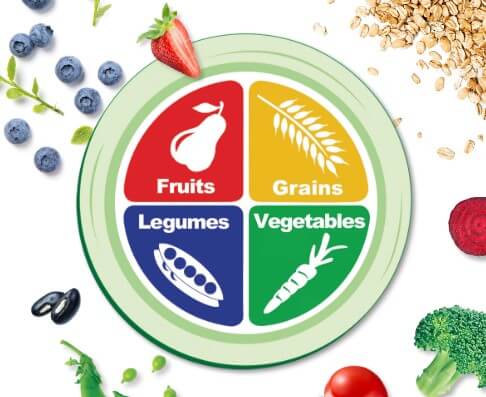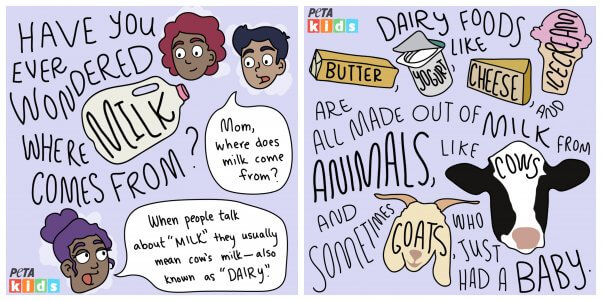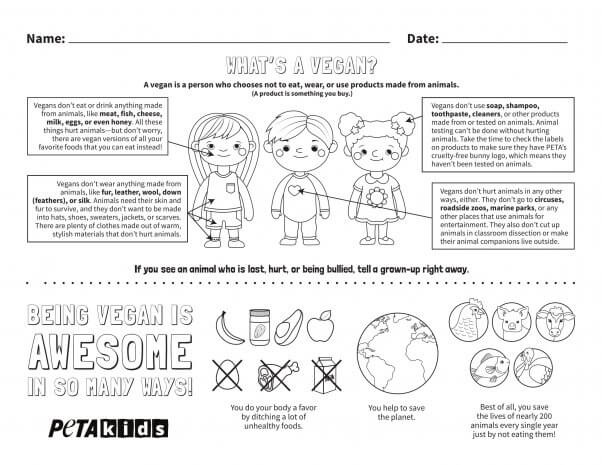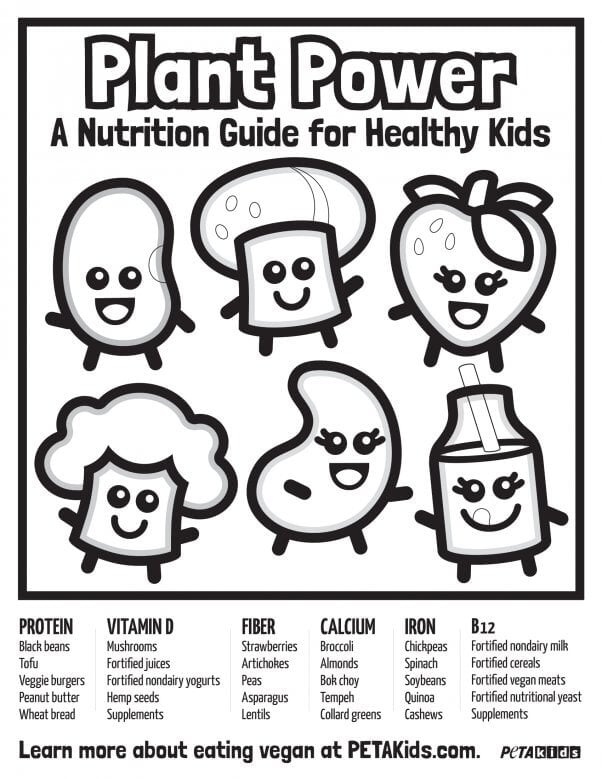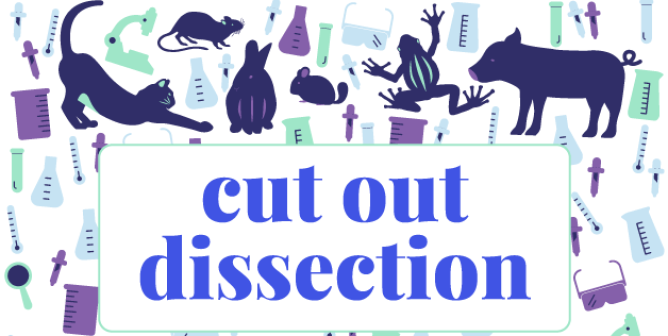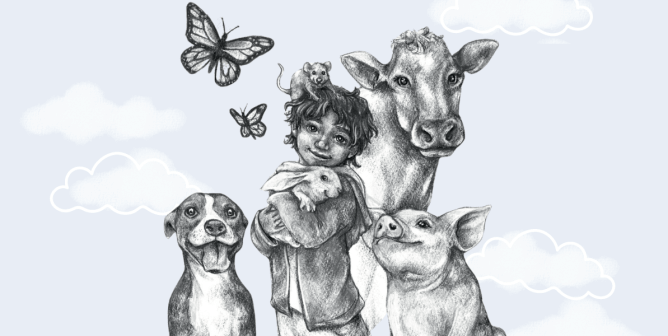Teach Students the Importance of ‘Veganizing’ Their Plates
Most of us are familiar with the food pyramid or other nutrition guides designed to help kids and adults eat healthy, balanced meals. But there’s nothing healthy about eating dairy, meat, or eggs. Embracing a vegan lifestyle is healthier for our bodies, beneficial for the planet, and kind to all animals.
Share this information with your students when studying health and nutrition so that they can make healthy, compassionate food choices that will benefit them for years to come.
The Truth About Dairy
Cow’s milk, cheese, and other dairy foods were once touted as giving a calcium-rich boost to weak, frail bones, but they may actually be harming rather than helping you and your students.
The milk produced by cows is formulated specifically for their calves, who are taken away from them so that humans can have the milk. In addition, people who consume dairy absorb less calcium than those who get their calcium from veggies.
A great resource to share with your students when discussing dairy is the PETA Kids comic strip above.
Calcium
According to the Harvard School of Public Health, “Calcium is a mineral most often associated with healthy bones and teeth, although it also plays an important role in blood clotting, helping muscles to contract, and regulating normal heart rhythms and nerve functions.” Teach students that calcium is plentiful in the plant world. Good sources of it include dark-green leafy vegetables such as collard greens and kale, cruciferous vegetables such as broccoli, soy foods such as tofu and edamame, other beans, almonds, sesame tahini, figs, and calcium-fortified plant-based milk and orange juice.
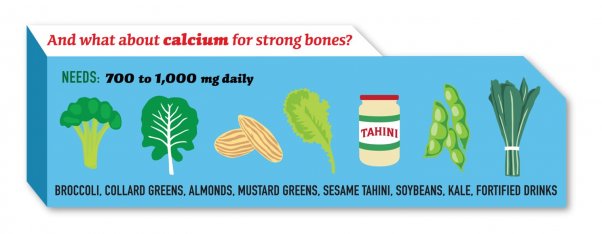
Protein
The Harvard School of Public Health also states, “Protein is found throughout the body—in muscle, bone, skin, hair, and virtually every other body part or tissue. It makes up the enzymes that power many chemical reactions and the hemoglobin that carries oxygen in your blood.” Our bodies are made up mostly of different kinds of protein that consist of varying combinations of amino acids. In much the same way the 26 letters of the alphabet can form millions of different words, the 20 amino acids form different proteins.
Unlike animal-derived protein sources, plant-based protein contains healthy fiber and complex carbohydrates. Sources of vegan protein are widely available in stores and are likely already in your pantry or part of your next meal. Reiterate to students that they can obtain protein from foods like beans, tofu, or bagels. Whole-wheat bread, peanut butter, and potatoes are also great sources of protein!
Learn more about plant-based protein sources with our friends at Lean and Green Kids.
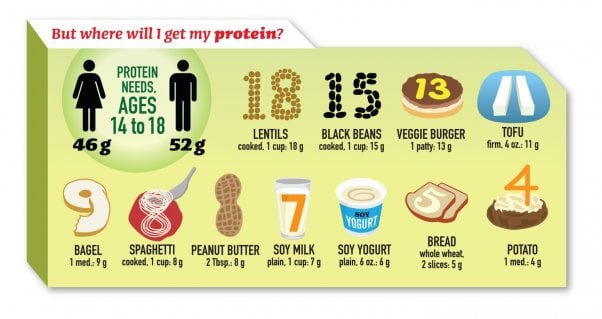
Eggs
Chickens are smart, social, sensitive animals who deserve much better than the abuse and suffering that they endure in the egg industry. Their eggs are high in cholesterol and saturated fat.
The good news is that cutting out eggs is easy. Today, there are many delicious and humane egg-free options that you can share with your students. Check out our favorite egg-free alternatives and recipes.
Fruits and Vegetables
Fruits and vegetables are great sources of essential vitamins, minerals, and antioxidants. Encourage kids to add them to their favorite recipes. Use “Eat Green!” by Dr. Jean Feldman to have your students sing about the colors of the rainbow while teaching them about healthy fruits and veggies!
Grains
Grains are starchy foods abundant in carbohydrates that give us energy. This group includes wheat, rice, oats, barley, and foods made out of grain, such as bread and pasta. Ask students to name some other foods that belong in the carbohydrate group.
Check out these resources from the Coalition for Healthy School Food that take a closer look at the nutrients needed to maintain health.
Helping the Environment and Animals
Animal agriculture requires massive amounts of land, energy, and water; results in polluted land, water, and air; and causes immense animal suffering. Even the United Nations (UN) has acknowledged that raising animals for food is “one of the top two or three most significant contributors to the most serious environmental problems, at every scale from local to global.”
Explain to students that we can all help slow down climate change, stop polluting, and help heal our planet by choosing vegan foods. A report by the UN concludes that a global shift toward vegan eating is vital if we are to combat the worst effects of climate change. In addition, the Worldwatch Institute, the Sierra Club, the Union of Concerned Scientists, the National Audubon Society, and Al Gore’s Live Earth all say that raising animals for food damages the environment more than just about anything else that humans do.
It’s no longer enough to teach our students to recycle or turn off the faucet while they’re brushing their teeth. If we want to avoid doing irreparable damage to the environment, we must be willing to discuss and implement real solutions to the climate crisis, starting with changing what we eat.
‘What’s a Vegan?’ Coloring Sheet
TeachKind’s “What’s a Vegan?” coloring sheet is perfect for elementary school students. It not only succinctly defines the word “vegan” but also uses kid-friendly language to explain why going vegan is important. Have younger students follow along as you read each paragraph aloud, or invite older students to take turns reading to each other. Then have them color in the pictures as they enjoy a healthy vegan snack or watch inspiring rescue story videos.
‘Plant Power’ Coloring Sheet
TeachKind’s “Plant Power” nutrition guide can provide students with another activity. As you distribute the accompanying coloring sheet, inform them that vegan food not only saves animals’ lives but also is better for our health.
Creating a Vegan Plate
Using magazines, glue, and paper plates, students can cut out images of vegan foods and create a visual representation of a healthy vegan meal. Make sure students choose a protein, a grain, a fruit or vegetable, and a calcium source. For a simpler version of this activity, they can just draw their favorite vegan foods on their plates.
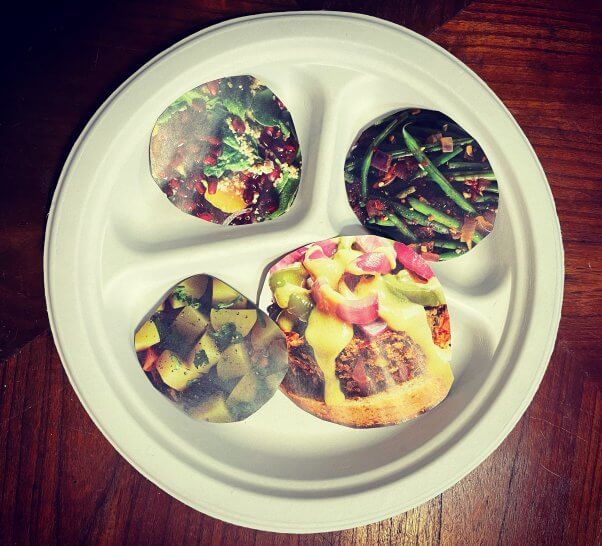
*****
Need more inspiration to help you incorporate humane education into your school curriculum? Sign up for TeachKind News:
By submitting this form, you’re acknowledging that you have read and agree to our privacy policy and agree to receive e-mails from us.

